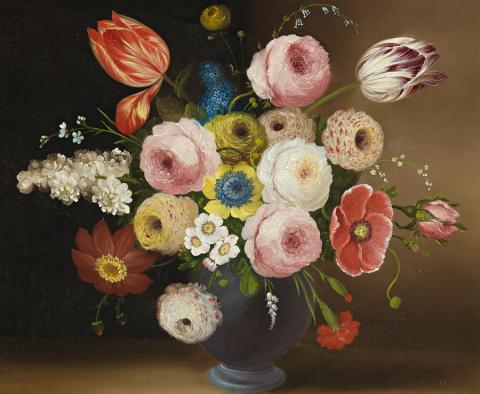FLOWERS IN A BLUE JUG, c.1850
WILLIAM BUELOW GOULD
oil on canvas
40.0 x 48.5 cm
signed and inscribed lower centre: W.B. Gould. Painter
Private collection, Melbourne
Sotheby's, Melbourne, 21 November 2006, lot 167 (as Still Life of Flowers)
Private collection, Hobart
Still Life, Flowers in a Blue Jug, c1840, oil on canvas, 59.7 x 47.0 cm, collection of the Allport Library and Museum of Fine Arts, State Library of Tasmania, Hobart
The artists of colonial Australia were fascinated by the extraordinary flora and fauna of the Antipodes, giving their art its special appeal, redolent with history and the individualities of the age. William Buelow Gould made numerous studies of the botanical and marine life of Tasmania, his pioneering studies being highly valued today for their scientific accuracy. His still life paintings in oil are quite a different matter, being mainly of English subjects, their quiet dignity in sharp contrast with his pitiful life. The image of Flowers in a Blue Jug c1850, with its calm beauty, entrancing colours, and innocence could not be further from Gould's alcoholic affliction, gambling, and theft. Born in Liverpool, the son of the Mersey river pilot James Holland, Gould studied under the Royal Academician William Mulready. His interest in the seventeenth-century Dutch masters was an early influence on Gould. This was extended through Gould's later work at the Spode, Staffordshire potteries, where it is thought he provided floral and scenic decorations for their famous porcelain wares. As Gould's life spiraled downwards, he deserted his wife and child, and adopted the name 'Gould'. In 1827 he was sentenced to transportation for seven years for stealing clothes.
Gould arrived in Hobart Town in December 1827. Here, under better times, he was assigned to the colonial surgeon Dr James Scott, to do watercolours of botanical specimens Scott had collected.1 Alcoholism and related misdemeanours, however, saw him spending time at the notorious Macquarie Harbour penal settlement where, in 1832 he made a number of studies of marine life for William de Little.2 Gould's emancipation in 1835, followed by marriage to Amy Reynolds, introduced a short period of relative stability and a longer period of prolific painting. His work included portraits, landscapes, seascapes, theatre scenery, and, most of all, still life paintings of flowers, fruit, fish, and game. As in Flowers in a Blue Jug c1850 and similar paintings, the flowers are all non-Australian - tulips, roses, poppies, carnations, and the like. Those of game featured hares and pheasants; and the fruits were grapes and apples, likewise not native. These reminders of 'home' on the other side of the world were of great sentimental appeal to the early settlers, symbolized by the presence of forget-me-nots in our painting. The abundance of the flowers and their fine and accurate detailing shows the influence on Gould's art of still life paintings of the Dutch Golden Age. Furthermore, the overall flatness of the design more than hints of Gould's time as a decorator of fine porcelain. Even the jug has a touch of the iconic Staffordshire blue about it. Tradition has it that he used to swap his paintings for drinks.
1. 177 of these are in the collection of the Queen Victoria Museum and Art Gallery, Launceston
2. Gould's Sketchbook of Fishes is considered to be a highly significant historic document, its present standing being equivalent to that of a World Heritage listing.
DAVID THOMAS
